NAGASAKI: A City With Thousand Hills, Thousand Bays and Thousands Histories – (by: Neneng Tarigan, Indonesia)
Part 1: NAGASAKI: the City I loved.
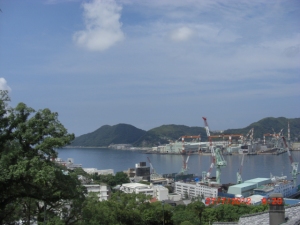 I first visited this city about 32 years ago in February 1980 as fellow participant of JICA (Japan International Cooperation Agency) in a program called: “Trade Promotion For ASEAN (Association of South East Asian Nations) Countries”; the program aimed at helping junior officials of ASEAN countries to improve their knowledge on Trade Promotion.
I first visited this city about 32 years ago in February 1980 as fellow participant of JICA (Japan International Cooperation Agency) in a program called: “Trade Promotion For ASEAN (Association of South East Asian Nations) Countries”; the program aimed at helping junior officials of ASEAN countries to improve their knowledge on Trade Promotion.
It was almost the end of the whole program and Nagasaki was the last city for us to visit. We were landed on the beautiful airport of Nagasaki on the man made island about 50 kilometers from Nagasaki City. There, we were welcomed by the beautiful Cherry trees (Sakura) in the early Spring time, and cherished by the beauty of the Cherry blossoms.
I was very much impressed by the beauty and the long history of Nagasaki. The city, was the first and the only gate for foreign visitors and international trade in Japan in 1543 until the Tokugawa era, as agreed by all of the Japanese Rulers in that period.
As the single gate, Nagasaki was the only entrance for Christian missionaries and traders from Europe, most particularly from Portugal and the Netherlands, the two countries that were having an intense trade with Japan that time. Regretfully however, the entering of Christian missionaries, had created a big resentment from the majority of the Japanese Buddhist people there, and that had driven these people into the battle against Christianity. Regardless of the battle, we still can see and read the true story about the Hidden Christian in Sotome, Nagasaki Prefecture, if we visit the libraries and the museums in Japan or looking at the remains of the influence of Christianity as indicated by the existence of some churches around the Sotome area as well as around Nagasaki City, up to these days.
The Modernization of Japan during the Meiji Restoration era had opened up the other cities in Japan as the entrance to foreign trade, and the role of Nagasaki as the single entrance was fading away with it. The name of Nagasaki came into the spotlight again after the involvement of Japan into the World War II that brought the city as the Atomic Bombing target on 9 August 1945. Now the city is slowly developed, as a quiet yet most beautiful panoramic city in Japan because of its thousand hills, thousand bays, thousands slopes and thousands histories. I was unable to count, how many tunnels and bridges they have there to connect the whole hills, but besides of the long history, the infra structure and the panoramic beauty as well the Mitsubishi shipbuilding factory, all of those and the friendly people have made Nagasaki as one of the most beautiful place on earth that really is worth visit!
Needless to elaborate about the history of Nagasaki. You can read the more complete version in http://en.wikipedia.org/wiki/Nagasaki or other sources, more comprehensive and accurate than what I have written here, or you can also see the pictures of Nagasaki by visiting my you tube at: http://www.youtube.com/user/NenengTarigan
Part 2: THE PAIN AND THE SHAME TO BEAR, AS THE COSTS OF THE WAR !
There, 32 years ago in Nagasaki, I met with four gentlemen from the Municipality Office. They are the Atomic Bomb survivors, they knew very well the pain the war has made and the costs that they have to bear along their entire lives.
Noboru Tasaki who lived about 5 km from the hypo center, was only 1 year old during the atomic bombing on Nagasaki 9 August 1945. Masanori Kawakami, who lived about 5 km from the hypo center was 2 years old; and Kazutoshi Yamashita as well as Yoichiro Yamaguchi who were living in separated areas about 3 km from the hypo center; respectively 5 and 14 years old of age at that time. Those 4 boys were terrified by the roaring sound of a big explosion. All of the windows’ glass and housewares in their houses were broken apart, they had no idea what was happening at about 11:00 am that day, they only saw the smoke and the sky became darker, they felt the heat, then run with their moms into the nearest sand bunkers and wait until everything subsided.
Actually, Nagasaki was not as a primary target of the A bombing that time. As I fully quoted from: http://www.historylearningsite.co.uk/bombing_of_nagasaki.htm
” Nagasaki was not America’s primary target. This was Kokura. The three potential targets for a second bomb were Kokura, Kyoto and Niigata. Nagasaki was only added to a list of potential targets when Kyoto was withdrawn (it had been the secondary target for a second bomb) because of its religious associations. The third potential target was Niigata – but this was withdrawn from the list as the distance to it was considered to be too great. Therefore, the Americans were left with just two targets – Kokura and Nagasaki.
Nagasaki was a major shipbuilding city and a large military port. But it was not a favored target as it had been bombed five times in the previous twelve months and any damage caused by an atomic bomb would have been difficult to assess. Also, the way Nagasaki had grown as a port meant that the impact of a powerful bomb might be dissipated as the city had grown across hills and valleys. The city was also broken up with stretches of water. However, fate and the weather was to be Nagasaki’s undoing. “
About 40’000 people were killed by the A bombing on Nagasaki that day, most of them were children, women, elders and workers of Mitsubishi Shipyard, since most men were posted abroad, especially for the occupation of Japan in Indonesia.
I went to the Atomic bomb museum, watching the remains of the A bombing in my field study in 1980. Yes, the Atomic Bomb Museum is the only place to see the remains of the atomic bombing of Nagasaki, since the Japanese government renovated and built the city soon after the bombing. The Samurai spirit; they admitted of being defeated, but with honor, that they can always rebuild!
Those four boys who became gentlemen then, were very kind to the participants of the Trade Promotion course, I was very much impressed by their friendly attitude and becoming their close friends and even as their families ever since. Here after 32 years, I visited them again, I visited Nagasaki, the city I loved.
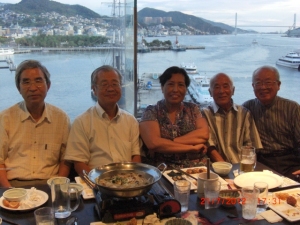 “The four boys”, my four beloved brothers
“The four boys”, my four beloved brothers
”The four boys” and thousand others of the A bomb survivors have severely affected by the A bomb radiation until today. Few years ago, the eldest “boy” (Yamaguchi) had to pass an abdominal cancer operation, and the second eldest (Yamashita) had to endure 4 times cancer operations within his life, first in his rectum, secondly in his abdominal, thirdly in his malignant or chest and recently in his abdominal again; and that man, Yamashita, is a very devoted Christian! Many people in Nagasaki, who survived from the A bomb and lived nearby the hypo center that time, suffered by various kinds of cancer as they are growing older now. That is so sad to know about the consequences of the atomic bombing ········!!!!
In the next paragraph, I wanted to convince the world to say no to the use of the atomic bombing or all weapons of mass destruction, such as: chemical, missiles and nuclear! Beware, that, war would only advantage the greed leaders. The great leaders will say a “big no” to it!!!
Part 3: REMEMBERING THE ATOMIC BOMBING: Peace Messages from Nagasaki.
“The Boy Standing at the Crematory in Nagasaki 1945”
This picture tells us everything! The boy was biting his lower lip, to keep and hide all the pain he was bearing!!!
No more war please!!!!!!!
The picture and the words below, I quoted from Joe O’ Donell, a photographer of the American Military, 1945. From the collection of the Atomic Bomb Museum, NAGASAKI.
~ The boy about 10 years old, he was barefoot, he was carrying a baby slung on his back. The infant’s head was tipped back as if the baby was fast asleep; in fact, the baby was already dead. The boy came to the ground with serious purpose, to cremate his dead brother. ~
Nagasaki after the A bomb.
A school girl’s lunch box
The evident at the Atomic Bomb Museum, Nagasaki.
No more war in this world please ····
~ This is a memento of Satoko Tsutsumi (14 years old at the time of the bombing) who was exposed to the Atomic bomb explosion in Iwakawa-machi about 700 meters from the hypo center. The rice in the lunch box was charred by fires after the bombing. Satoko’s name and class number are written at the bottom of the lunch box~
Here, I and my sister K. Tasaki (Noboru’s wife), in front of the house of Madame Butterfly with a family from Hiroshima, whose grand dad was also an atomic bomb survivor of Hiroshima.

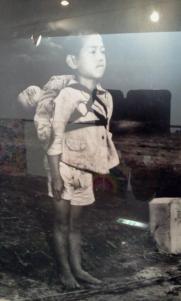
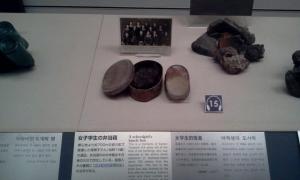
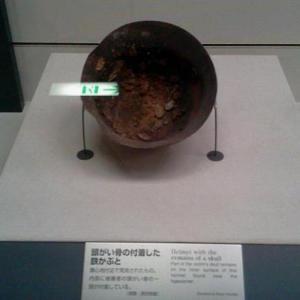

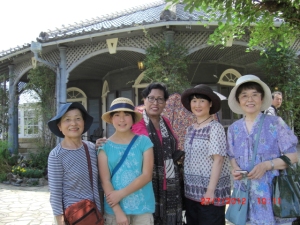
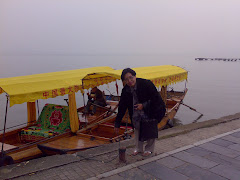






![[CARTOON] Darth Vader Vacation. cartoon, DarthVadar, spoof, StarWars, vacation](https://i0.wp.com/4.bp.blogspot.com/_6Un-_YHrxJo/TPmWajI6V3I/AAAAAAAABo8/sqCTedATzgI/s320/toon1062%2BDarth%2BWader.jpg)




